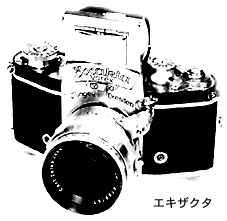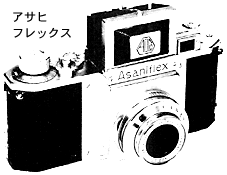TopMenu

Masahiro Yoshie
Previous Head of Photography Publishing Dept.
Asahi Newspaper Company
 It was about Showa 34 or 37 years ago when the Single reflex generation began and the 'Asahi Flex' and 'Nikon F' were released. The Canon Ref no. 1 also was in Showa 34. There are a lot of people who think that the single reflexera started then but, Japanese produced single reflex lenses started 7 yearspreviously. The It's not a Pentax 'Asahi Flex', was released in Showa 27 andthis was Japan's first single reflex camera.
It was about Showa 34 or 37 years ago when the Single reflex generation began and the 'Asahi Flex' and 'Nikon F' were released. The Canon Ref no. 1 also was in Showa 34. There are a lot of people who think that the single reflexera started then but, Japanese produced single reflex lenses started 7 yearspreviously. The It's not a Pentax 'Asahi Flex', was released in Showa 27 andthis was Japan's first single reflex camera.
The 'it's not a Pentax' was the same Pentax that was released by the Asahi Company after a few years, but a real picture could be seen with the finder.The pentaprisms they use today in single reflex cameras is taken for grantedbut, with the Asahi Flex you needed to look through the finder from the topto take photographs.
I bought this camera when it was first released. It was the time when I wasa normal salaryman who was thinking whether or not to make photography intoa profession - 2 years before I entered Asahi Newspaper Photography Publishing Dept.
Why in this time, did camera magazines unanimously place introduction articles about the West German produced single reflexed camera 'Exacta', and broadcast loudly about its first rate performance? I was puzzled by the twin lens reflex camera 'Parallax' (discrepancy of the range of vision between the finder lens and the photography lens) which I had been using, and I thought if it was possible to get a single reflex camera like the Exacta, I would beable to take wonderful photographs. People from the camera magazine'Arusu' like Kunio Kitano were praising this camera and it's fair to say it was thought that the cameras from that time were going to develop into single reflexcameras. Within no time of the 'Asahi Flex' advertisements published in themagazine, I couldn't stand it any longer and the money I had saved for the 'low lie code' was spent on buying one.
 You can see the taken picture 'as it is' from the film, meaning you can seethe left, right and oposite picture. The twin lens reflex cameras had a different feeling and freshness about them. It's difficult for it to catch up with moving subjects so taking closeups of flowers at random suited it well, and I had fun looking through the finder.
You can see the taken picture 'as it is' from the film, meaning you can seethe left, right and oposite picture. The twin lens reflex cameras had a different feeling and freshness about them. It's difficult for it to catch up with moving subjects so taking closeups of flowers at random suited it well, and I had fun looking through the finder.
The Asahi Flex came with a 50mm f3.5 lens but the aperture didn't have an auto mechanism. In detail, pressing the shutter button of the single reflex cameras of today, ascends a mirror,the aperture moves, the shutter freezes andafter this the aperture releases again. The mirror then of course goes backto its original position, but in those days the cameras weren't so kind to the user. At the most, the auto preset was before using the aperture recoveryto set and focussing was achieved using the full aperture metering, a mechanism was attached which was stopped by the aperture recovery and the turningof the ring. However the first Asahi Flexes didn't have this so the point upto photography was a little nusiance.
Within one month of walking around with it, if there are faults that you can't do anything with, don't use it. Talking of faults, I mean the heavy shutter. The reason being the Ever Set Mode which was the mode when the oppositemirror popped up when the shutter button was pushed and went down when you released your finger. So you needed to push pretty hard with your finger on the shutter button to firmly put down the mirror. It may be a little exaggeration, but taking 10 photos in a row will hurt your finger and you may not beable to take any more. Going out in the open air on my day off, spending a day walking around totally engrossed in taking photos, ocassionally my fingers hurt for a few days later and I wasn't able to even write. Even using therelease ends up in breaking it.
I don't really remember this camera's reputation at the time, but later whenthe Asahigaku company released the quick return mode on the IIB type, production of the 'Asahi Pentax' which was the single reflex camera with the pentablism was started. This was probably the first camera produced by hearing ofits reputations and dissatisfactions. By listening to its users's hopes and desires, the performance of the camera improved and the epoch best selling camera, the Pentax, was born.
However, for me I didn't like this Asahigaku camera and I decided to go fora nonreputable camera. When I think back to the physical pain of my index finger, I really lose my appetite. After that I never bought a camera from this company. Not limited to cameras, with any product you get left with an unpleasant after taste or a pyschological affect.
When people play around with cameras they do think think about the performance but, including style people are influenced by the psychological affect they feel. An aeronautics and space criticist that knows well about the airplane fan Mr Sanuki, his report 'airplane styling' (Green Arrow publishing March 1996) comments about the good styling of airplanes.Within these comments, Mr Sanuki claims "since the the first airplanes of the Wright brothers, it was thought that by calculation and experience and skills of the excelling performance, that superb styling could be achieved. Butwith only this, there are limits to superb styling. Superb styling has to besecured by uplifting the spirit of the flight passengers". "By creating thefeeling of 'wanting to fly, wanting to board a plane' that airplane has to have confidence in itself and its purpose of not losing to any other plane. Styling is a motive of stirring up the people's spirit."
I think I'm not the only one who thought it's the same kind of thing in photography when I was reading this. A camera that makes you want to go out andtake photos. Mr Sanuki talks about a feeling of rousing up courage but, there are cameras that make you stir up courage and motivation. However on theother hand there are cameras that make you lose your desire to take pictures.
 You can see the taken picture 'as it is' from the film, meaning you can seethe left, right and oposite picture. The twin lens reflex cameras had a different feeling and freshness about them. It's difficult for it to catch up with moving subjects so taking closeups of flowers at random suited it well, and I had fun looking through the finder.
You can see the taken picture 'as it is' from the film, meaning you can seethe left, right and oposite picture. The twin lens reflex cameras had a different feeling and freshness about them. It's difficult for it to catch up with moving subjects so taking closeups of flowers at random suited it well, and I had fun looking through the finder.
 It was about Showa 34 or 37 years ago when the Single reflex generation began and the 'Asahi Flex' and 'Nikon F' were released. The Canon Ref no. 1 also was in Showa 34. There are a lot of people who think that the single reflexera started then but, Japanese produced single reflex lenses started 7 yearspreviously. The It's not a Pentax 'Asahi Flex', was released in Showa 27 andthis was Japan's first single reflex camera.
It was about Showa 34 or 37 years ago when the Single reflex generation began and the 'Asahi Flex' and 'Nikon F' were released. The Canon Ref no. 1 also was in Showa 34. There are a lot of people who think that the single reflexera started then but, Japanese produced single reflex lenses started 7 yearspreviously. The It's not a Pentax 'Asahi Flex', was released in Showa 27 andthis was Japan's first single reflex camera.